When you think of South American football, the first thing that comes to mind is Argentina and Brazil, Neymar and Messi, Pelé and Maradona. You think of greatness, the biggest in the sport’s history. Their unique way of playing football has characterised them for over 50 years and more, which can be defined as brave, rebellious, inventive, and fun. An example was how Ronaldinho treated the ball whenever he was on the pitch.
It can all be explained with history, the meaning of South American bravery and creativity when playing football, but if we don’t dig that deep and think of the simple, we can think of how kids play barefoot, which adds more control, as well as the poor pitches youth players typically perform in during their first years playing football, controlling the ball softly in these circumstances, meaning in better situations, they could drop down the ball with such high quality.
However, these two countries, Brazil and Argentina, have been the most significant contributors of the continent in producing high-quality gems that can be developed to go on and stand out in Europe, such as recent examples: Enzo Fernández and Vinicius Jr.
Venezuela, for example, is a tiny nation in this regard, especially in having players with solid mental, tactical and physical attributes to stand out in the big leagues of Europe.
The last one was Juan Fernando Arango, a unique attacking midfielder from the ’00s, left-footed, freely roaming all over the pitch, linking up attacks between midfield and forwards, and also finishing himself actions with his superb ball-striking. This Venezuelan legend could stay long years between Spain and Germany, playing for RCD Mallorca and Borussia Mönchengladbach.
Brazil is famous for its ‘samba-style’, which combines a football playing style with the dance movements of the musical genre, the two creating a prominent expression of who they are to the world: pure joy and inventiveness.
Venezuela, for its part, has ‘Tambor’, similar to the Brazilian Samba, and David Martínez, aged 17, likes to dance while he’s driving with the ball glued to his feet, showing the world the Venezuelan style: Caribbean, rebellious and inventive, drawing recollections of footballers who were unique and highly desired in the past; the ‘10’, but with some different attributes that we will be describing in this piece.
In the form of a tactical analysis, this scout report explores how David Martínez plays, and how he fits inside the tactics of Venezuela + Monagas. This analysis takes into consideration various parts of his attacking game and also goes deep into data.
Profile
David Martínez was born in El Tigre, Anzoátegui, back in 2006, meaning he’ll be 18 next year, specifically in February. At only 16 years of age, he made his professional debut for Monagas in the Venezuelan’s top tier. He scored his first goal the third time he started in his team’s XI and contributed with an assist. He ended the 2022 season with four goals, three assists and as runner-up of the tournament, playing 24 minutes in the final and scoring his penalty in the penalty shootout at only 16 years old.
2023 started with a high for him, being called up with 17 years to the Venezuelan U-20 National Team, which was coached at the time by Fabricio Coloccini. The tournament, which was the qualifier for the U-20 World Cup that was won later by Uruguay, wasn’t the best for Venezuela but started to show glimpses of how David could charge responsibilities in a team with more age than him and against older opponents, being one of the only positive notes of the Venezuelan team in those matches.
Four months later, the U-17 Venezuelan National Team, coached by Ricardo Valiño, had the same tournament but for the U-17 World Cup, which is going to be played in Indonesia. The Argentinian manager, the captain of the squad, designed David Martínez. He ended up scoring four goals and three assists in eight matches, concluding in the qualification of Venezuela to the World Cup. Two months later, he debuted in a friendly match for the Venezuelan National Team.
As reported by trusted Venezuelan and Argentinian journalists, he’s set to sign with Ajax once he turns 18 years old, meaning he’ll travel to the Netherlands in the January Transfer Window, making him the biggest transfer in Venezuelan football, especially for the meaning of the jump, as he will go from his country, directly to one of the most historical teams in the world.
Dancing across the pitch
David Martínez can be defined as a unique player from Venezuela because of his technique, vision, and capacity to make such a significant impact in the final third. Still, the term ‘unique’ is also used explicitly because he is different from all the other talented players that have been showing attributes in the past decades for Venezuela.
He’s primarily being deployed as a right-winger, a position that suits him greatly, where he tucks inside constantly, looking to receive the ball between the lines, showing his ability to twist his body and leave opponents behind, with agility to do so inside his 178cm, escaping from tight spaces, and always with the ball very close to his feet.
A short dribbler is rarely seen in Venezuela as the traditional winger/forward is often produced, a long dribbler who wants to electrify attacks/transitions with rapid runs. He’s a player who can carry the ball forward, making short and soft touches to the ball, showing it to the opponent, and hiding it between his feet while feinting with his body, combining different types of movements to keep the ball tied.
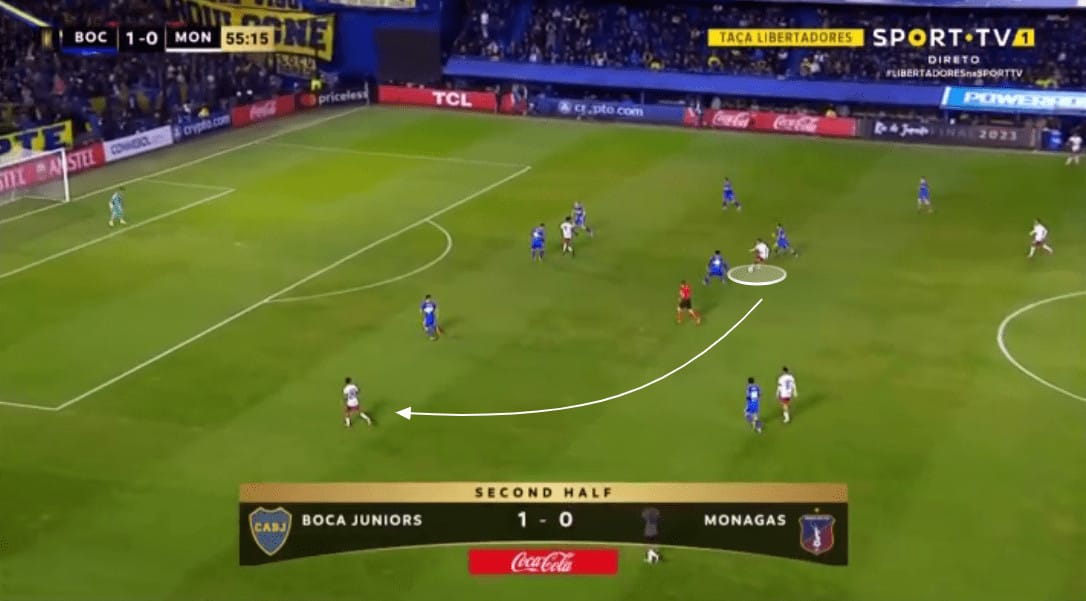
The first figure in this article shows us several things about Martinez’s style of play, as he has received between the lines, attracted two players, and is brave enough to get closer to a 1v1 duel. Subsequently, he dribbles the Boca Juniors player and releases a pass to the wings. However, let’s not dig deep into his passing just yet, and we will focus on his dribbling.
David usually likes to pick up the ball on the right; it can be on the wide channel or also in the half-space, showing excellent resources in both zones of the pitch in terms of how he orients the ball and manages the pressure from behind or on top of his shoulder.
The Venezuelan likes to duck and lift his body while facing opponents, especially ducking when he’s in tight spaces, where he wants to take advantage of his low centre of gravity.
However, what obviously stands out for a dribbler is what type of impact he can make with possession. He has shown a variety, from progressing and driving the ball forward to short runs where he breaks backlines, receiving between the lines and turning or leaving behind opponents with his feinting and, furthermore, using it as a pre-step to make the breaker pass or to shoot.
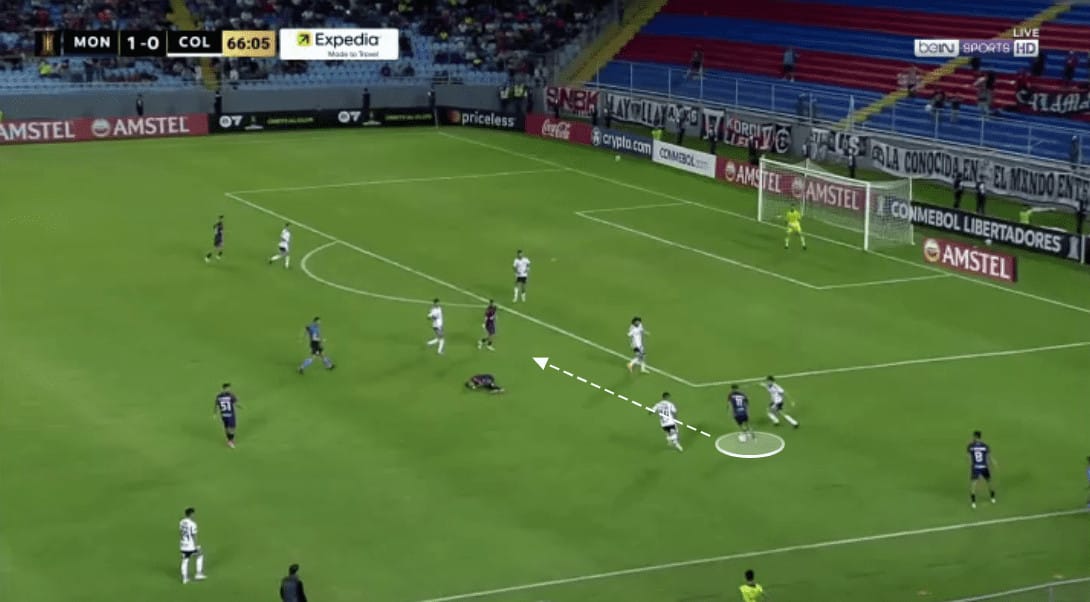
In the figure above, we can see an example of what we have mentioned recently with Martínez picking up the ball in the right flank after a second ball, he attracts the opponent and then cuts inside, where he drives past two players and ends the action with another through pass into the box.
He’s also able to twist his body thoroughly, receiving with his back to the goal and creating advantages through this situation, one which only dribblers can create progression or winning fouls.
He’s not only producing short dribbles all over the pitch but also a pacey player who can win speed duels against opponents to penetrate the box in seconds.
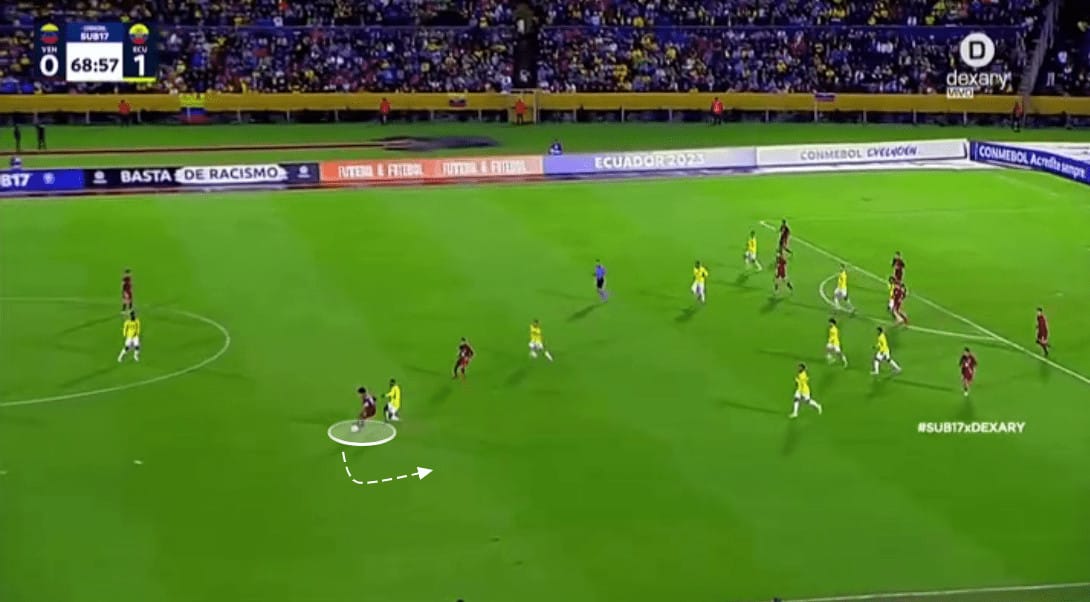
One of the typical movements of David Martínez when dribbling is to face the opponent, feint with his body to go to one side, and then end up driving through another, usually looking for the inside of the opponent, where he can still control the ball on the far foot, which tends to be his left.
This is something that has to be done with exact timing and needs the agility to move the high quickly to make the opponent fall in the feint. If a player does this with an extra touch or second, he will lose possession. David likes to keep the ball rolling softly in this one, not entirely stopping, sees the rival player and makes the movement.
In the search for an end product that can result in important things to his team, he takes advantage of the spaces he has created to make a through pass or shoot from distance.
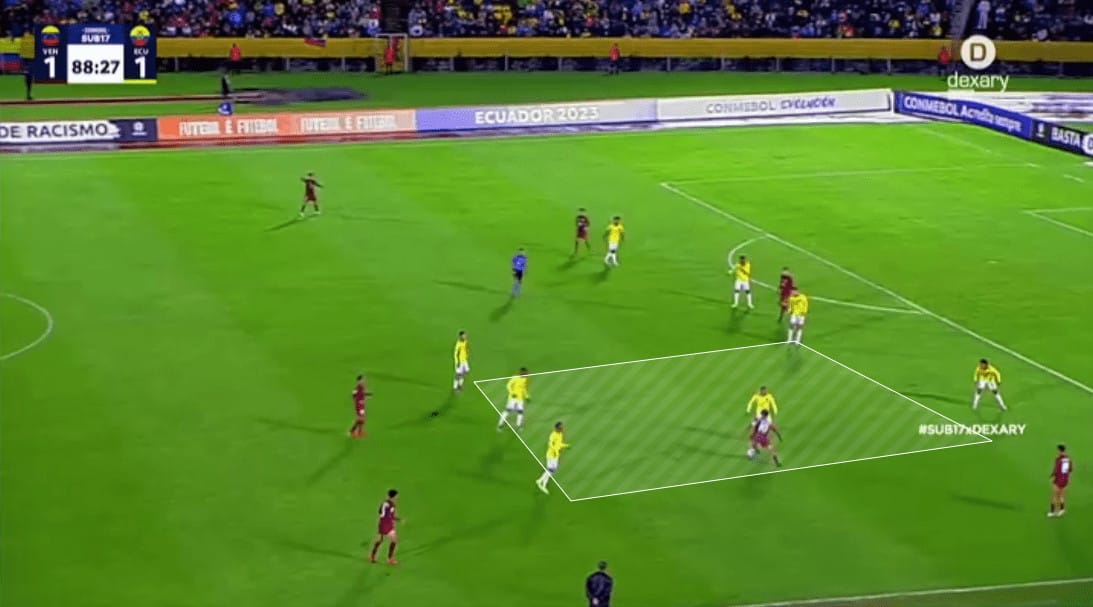
The striking thing about Martínez is that even being pressed, and despite having a light build, he’s so tricky to dispossess or even foul, driving while he’s being kicked. He’s not a typical winger who goes outside, gets to the by-line, and then crosses. He’s quite the opposite, receiving between the lines, acting almost as an attacking midfielder, living freely on the pitch, and taking down players with such agility and technique.
He manages various resources to dribble, which also impacts his game significantly, as he’s not regularly being dispossessed because of the predictability. He can turn his body while receiving with his back to goal, half-turning the opponent, feinting simply but effectively, and mixing short with mid-dribbling to go inside and shoot/pass.
He has a very 2000 style of playing football, especially when showing that natural dribbling ability, looking to make slow feints or actions but being so difficult to steal the ball off him. In the eyes of us, the spectators, some dribbles can be seen slow, but he carries their tempo and adds pace at the exact moment to pass the pressure/1v1 duel. That defines him as a dancer.
Ball-striking and linking-up
If the dribbling capacities make David Martinez a highly technical player, his ball-striking and ability to link up with closer and far teammates stand out the most, as his creativity and quality to make contacts with the ball.
He started to call attention in the Venezuelan’s top tier, especially for his vision and ability to break backlines with through passes. Still, when he showed his shooting technique, people were even more enthusiastic about his talent.
Martínez is not only a dribbler, he’s also a player who can produce a lot in the final third, from shots, goals, and assisting to linking up and making one-twos to then activate teammates going into space or running himself into the box after the link-up.
Especially when he arrived at the Venezuelan National Team processes, he managed to showcase the variety of resources to help his team progress/score. The way he strikes the ball from a long distance is superb, adding a variety of techniques to these shots, with the curled shot with his left foot to the far post being one of the most regular in his game.
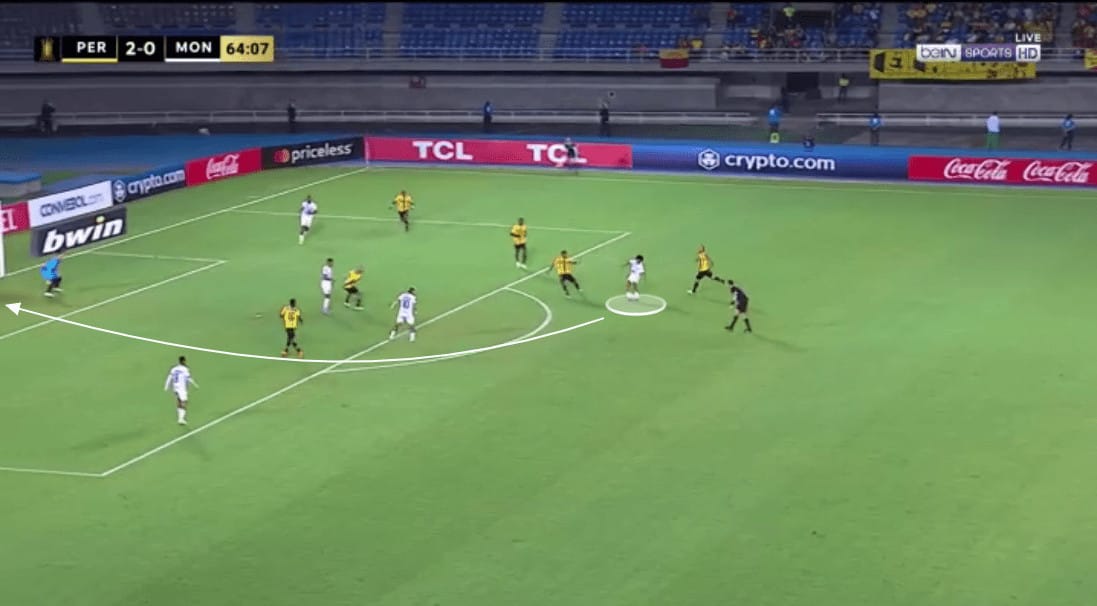
As the leader of the U-17 team, Martínez took responsibility, and he produced what he was asked for, with that age and pressure. Not only has he managed to make these types of things in that scenario, but he has played, scored, and performed at a high level in competitions such as CONMEBOL Libertadores against Boca Juniors, Colo Colo, and Deportivo Pereira, where in the minutes he had, he was the best player on the pitch and even manage to score a beautiful strike as shown in the picture above.
He’s also aggressive in attacking the box and managing transitions in different forms, which we’ll discuss later. However, he manages to penetrate the penalty area with runs into the far post or penalty spot occasionally, which could be threatening if he starts to do it more often.
On the other hand, striking techniques like volleys or low-adjusted shots are also seen in Martínez range of resources, showing his aggressive search to score and take the main part of his team in attack.
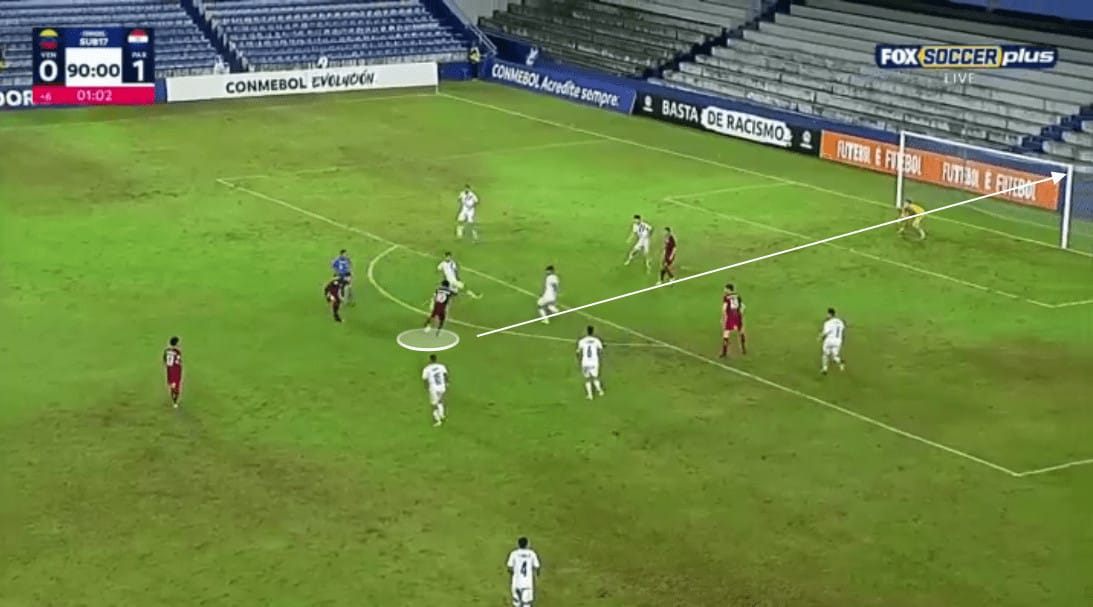
However, his shooting technique can be counter-productive; as he knows it’s terrific, he abuses it with a lot of regularity, not deciding well at moments when he had better passing options or maybe driving a little more yards to then execute the shot.
This is a typical issue for young players, especially those who play freely on the pitch and have these spaces constantly. If he can slow down the tempo at times, as sometimes he wants to shoot from long distances, not make reckless decisions, and evade the hit when the play asks for it, he’ll evolve a lot.
Nevertheless, Martínez keeps adding other attributes if his primary tools don’t work in a game. His ball-striking isn’t limited only to shooting, as he’s an excellent close and long-passer, varying the type of executions with his left foot and showing excellent accuracy in terms of the tension the play asks the pass to have.
His best attribute when passing is that he recognises when to break and when not, but he’s typically brave and vertical to make these executions. He’s mainly creating long switches to players that are penetrating the box into the far-post zone, where the weight of the pass from where he is to that far zone is exact.
However, he’s exceptionally varied when passing, able to command transitions with his dribbling and then creating the final pass, assisting teammates in scoring/shooting. He likes to make high executions rather than ground ones, but he’s also good at that.

David Martínez has the vision and ability to find teammates running into spaces behind, mainly because of how he orients his body and lifts his head to link up. He’s always looking to open his body and watch that far passing option to activate the isolated side of the field; he can create these passes in half-spaces and from the wings, too.
All these exemplary executions are eradicated in how he puts his left foot before the delivery, as he’s elegant in opening his foot to make the pass close a bit more. When creating chipped passes, he nails his feet to the ground to generate the necessary height and tension of it.
He’s varied, from long switches from one side to another, crosses into the penalty spot from half-spaces to outside-of-the-foot deliveries. He finds teammates running in behind for fun, having the vision, knowledge of the technique, and timing to activate them.
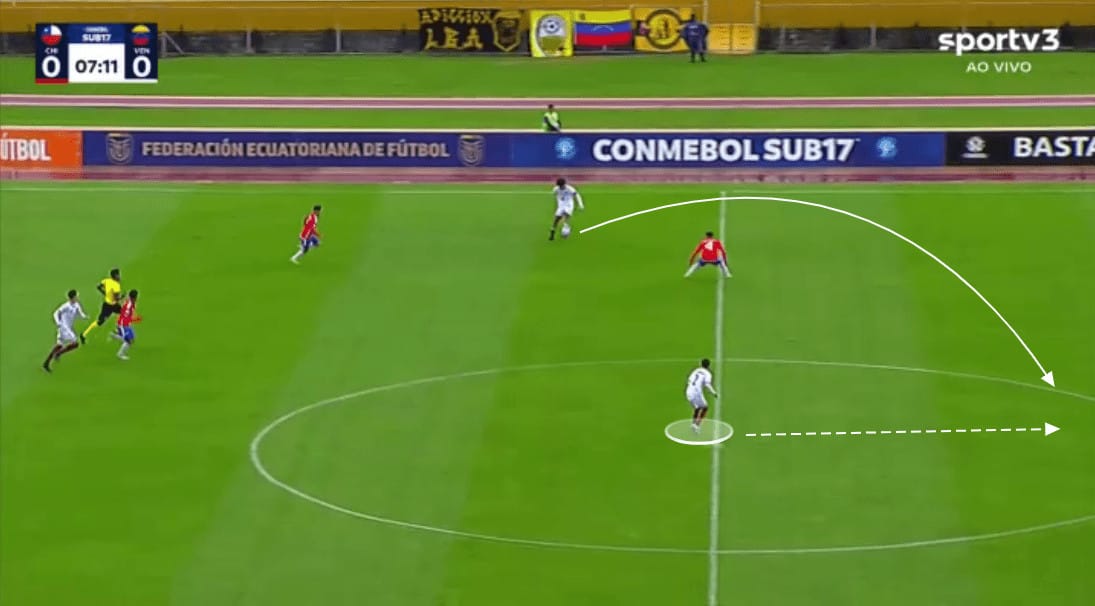
In the figure above, we can see his rebelliousness, the South American style of inventiveness: He’s receiving the ball in a 2v1 attacking transition, a player running in front of him behind the defender, and he dictates that the pass has to be made as soon as possible, and not to lose time orienting his body, he executes outside of the foot pass, or as they called it in Venezuela and others sites of South America, ‘Three-toes’, as players used the three toes of their foot to make these type of deliveries, the famous ‘Quaresma-strike’.
David rarely uses his weak foot, which should evolve in his game, too, especially when dribbling or linking up in tight spaces, as he could only sometimes create outside-of-the-foot passes.
On the other hand, he’s more than capable and likes to link up with closer teammates, especially to break deep blocks and backlines, generating short passes at the edge of the box, looking to make one-twos that send him into the box to shoot or assist.
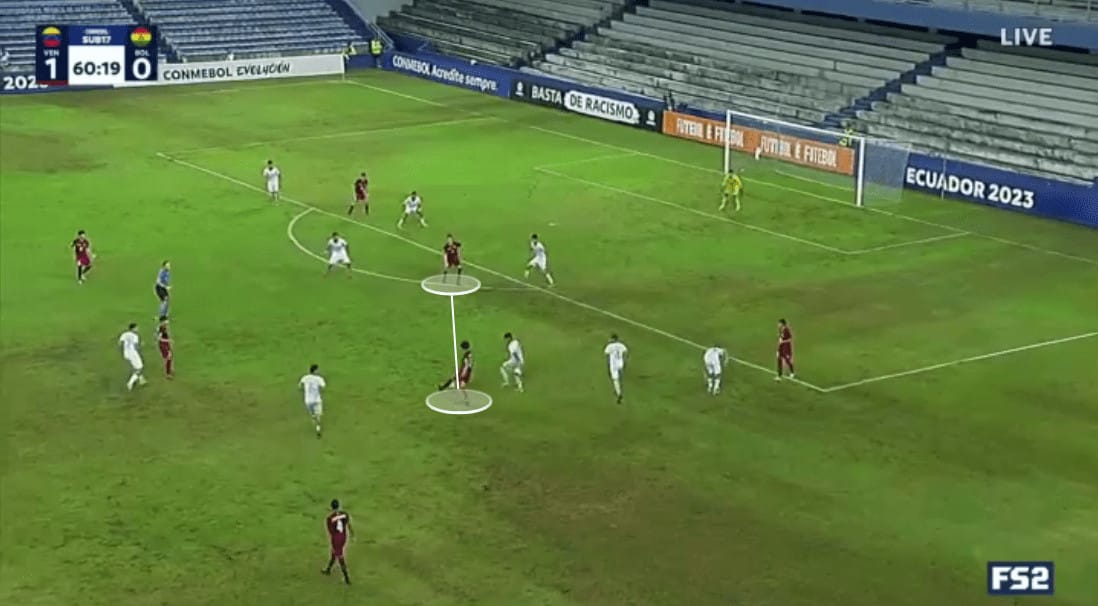
To pick a resource of David Martínez that should be his best would be too dull, as he combines ideally three, with some things to keep growing in terms of maturity and how he uses them regularly. Still, he’s a player who can surprise in attack in several ways, producing high-quality shots, through passes and dribbling opponents in tight spaces.
Comparisons to elite wingers/AMs.
Our app xGOLD will also have his part in this piece, looking for similar attacking midfielders and wingers in the top-five European leagues.
The first solid similarity we find in the 20-player list xGOLD gave us is Crystal Palace’s Eberechi Eze, with an 85% match, a player with a close style of play in his ball-driving and ball-striking. This is an excellent comparison considering the capacities of both players and the data also show some interesting points, as we can see in the radar below.
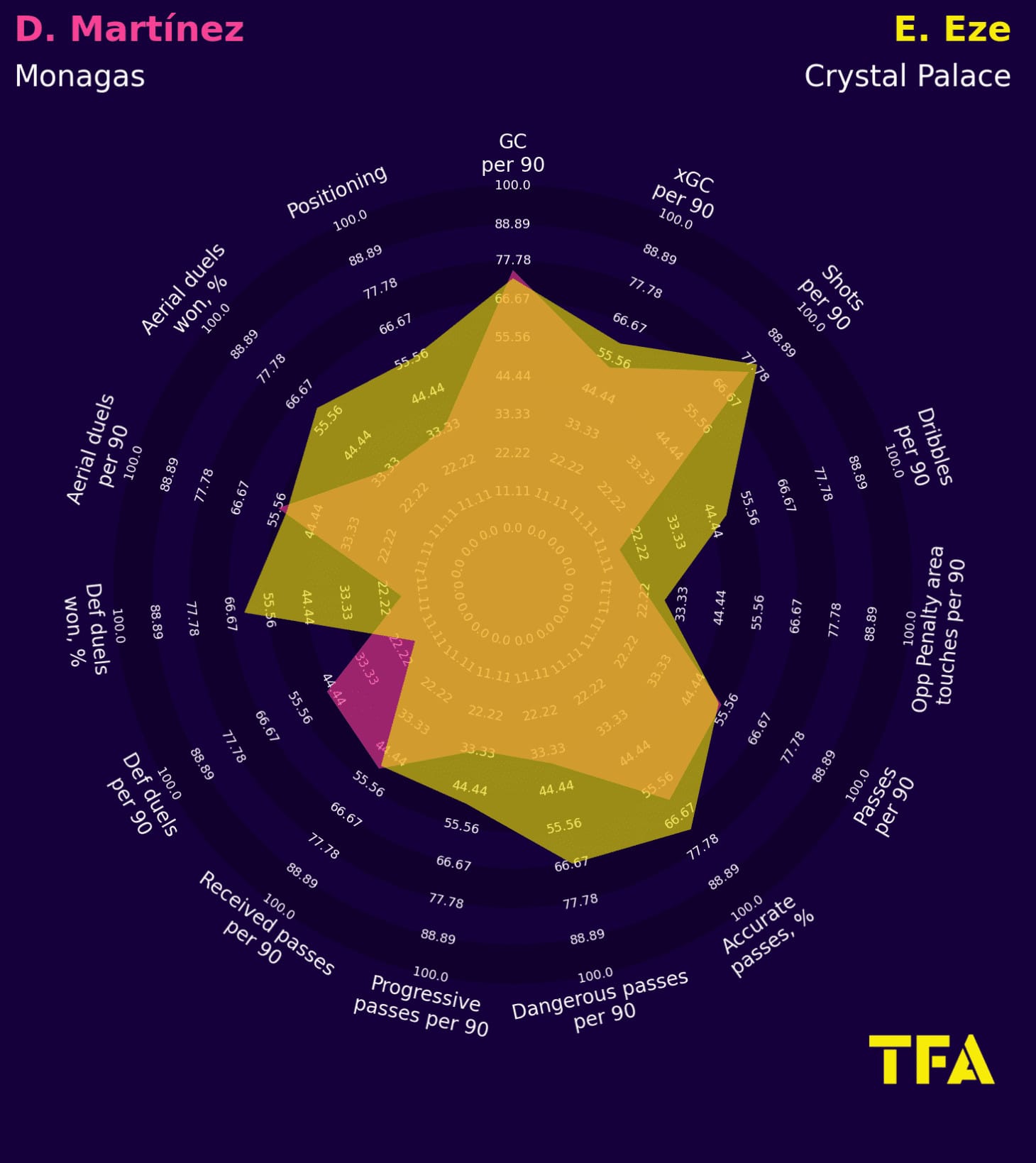
With 84%, we find the legendary Marco Reus, a player who loves receiving between the lines, has matured his game from a dynamic cutting to the inside from the wings to a player that dictates the tempo of his team in the inside channels and can drop into the base of the play or break backlines with his vision and passing ability, another with a top ball-striking technique.
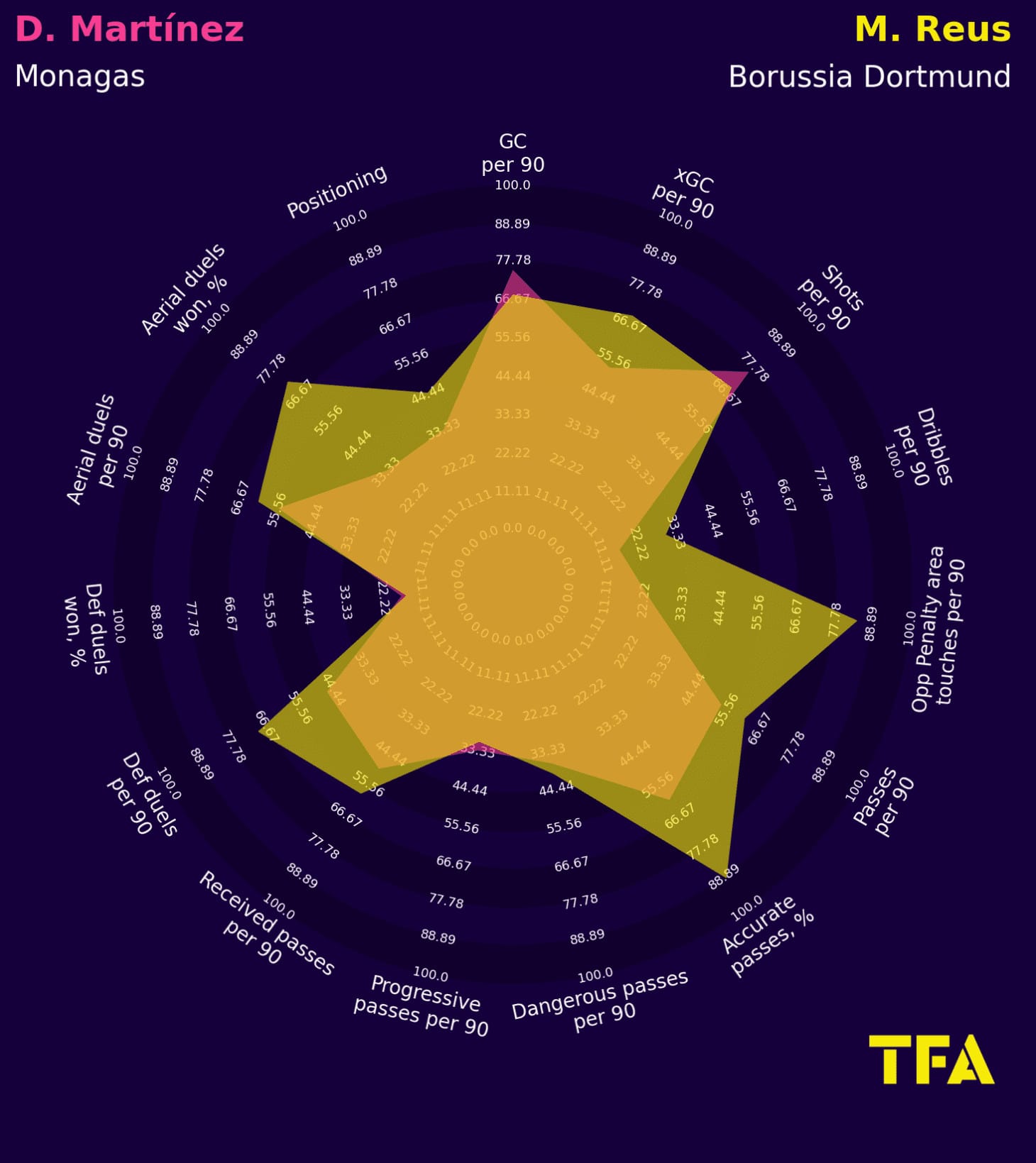
Last but not least, we find Téji Savanier with 83%. What caught our attention in this comparison and similarity is the ability of the French attacking midfielder to keep the ball tied to his feet, escape tight spaces with agile body feints, and then his ball-striking, especially to find teammates going in behind, as he’s an elite assister.
He is not the most famous player, but one who reminds us of Martínez’s attributes, with a very different style of playing, as Martínez is more dynamic, fast, and starts from a flank.
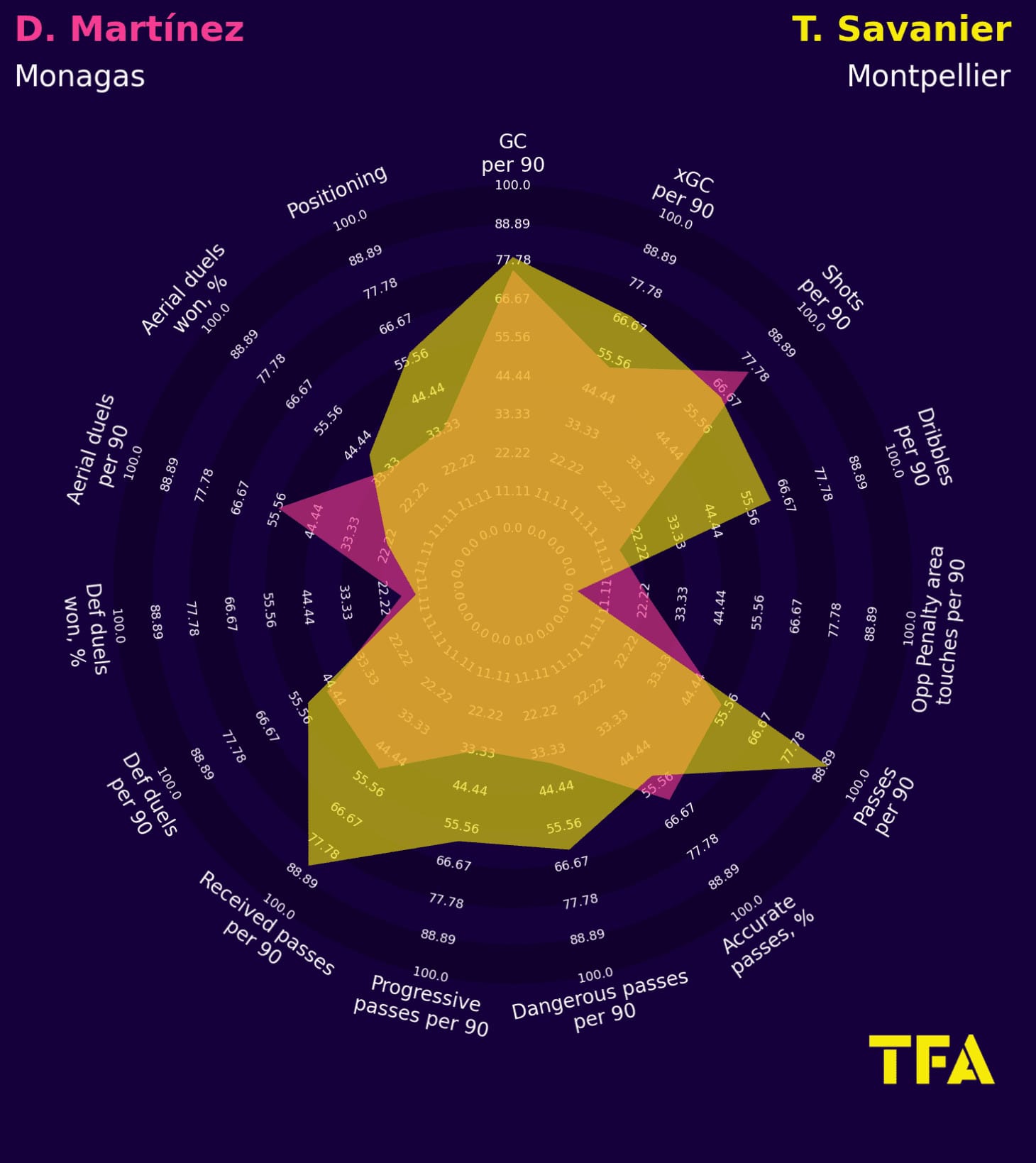
We must clarify that this is not a literal comparison of which player is best and if he could become the next Marco Reus or another player. It’s just a search through data to know where xGOLD defines David Martínez’s playing style close to elite footballers, to understand in a better, simple, and effective way, taking an example through statistics and video.
Venezuela’s leader
To conclude this piece, David Martínez has shown one of the highest potentials in Venezuela since Juan Arango did back in the ‘00s. There is a lot of pressure on the soon-to-be Ajax player, but he has, at least until the moment, very well, something different names haven’t done since they left Venezuela back in the day.
However, David has to work on how he deals with the leadership in Venezuela and can translate to different contexts in clubs. At times, he can take too much responsibility, making wrong decisions and even having some disciplinary issues in how he talks as a captain to the referee or opponents.
Taking care of that and maturing how he approaches these types of situations, David could improve massively and take the next step with Ajax — one of the best academies in the world — should be essential for him, even starting to play at the Eerste Divisie with Jong Ajax. His potential is very high, but to get into those peak stages of his level, he must stay concentrated to perform at the top level.






Comments